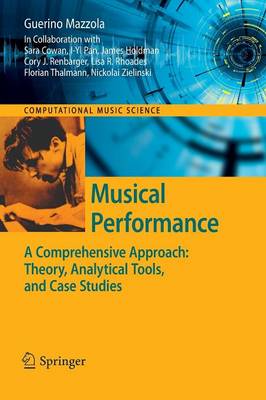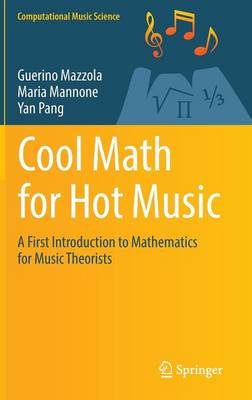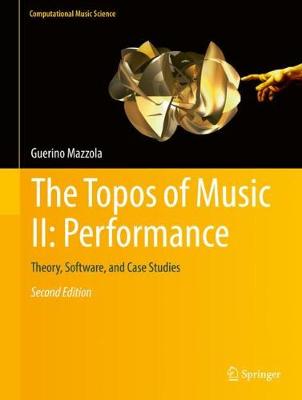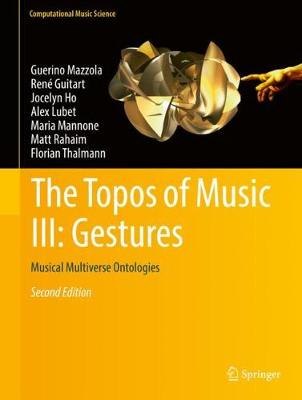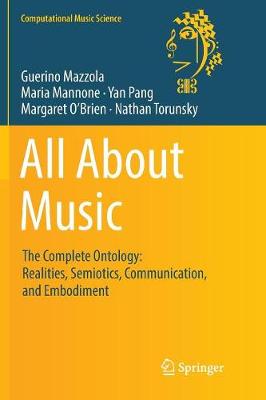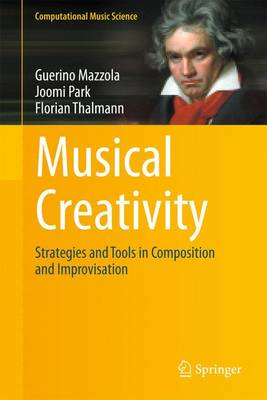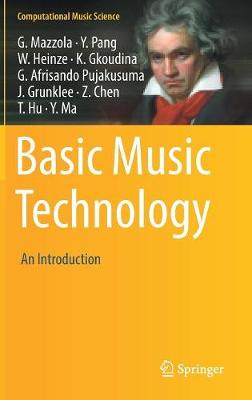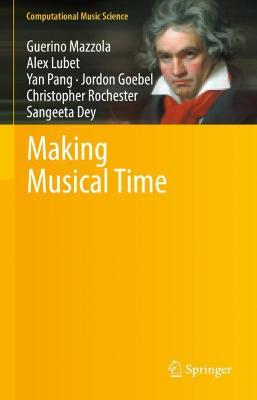Computational Music Science
12 total works
This book is a first sketch of what the overall field of performance could look like as a modern scientific field but not its stylistically differentiated practice, pedagogy, and history. Musical performance is the most complex field of music. It comprises the study of a composition’s expression in terms of analysis, emotion, and gesture, and then its transformation into embodied reality, turning formulaic facts into dramatic movements of human cognition. Combining these components in a creative way is a sophisticated mix of knowledge and mastery, which more resembles the cooking of a delicate recipe than a rational procedure.
This book is the first one aiming at such comprehensive coverage of the topic, and it does so also as a university text book. We include musicological and philosophical aspects as well as empirical performance research. Presenting analytical tools and case studies turns this project into a demanding enterprise in construction and experimental setups of performances, especially those generated by the music software Rubato.
We are happy that this book was written following a course for performance students at the School of Music of the University of Minnesota. Their education should not be restricted to the canonical practice. They must know the rationale for their performance. It is not sufficient to learn performance with the old-fashioned imitation model of the teacher's antetype, this cannot be an exclusive tool since it dramatically lacks the poetical precision asked for by Adorno's and Benjamin's micrologic. Without such alternatives to intuitive imitation, performance risks being disconnected from the audience.
Computational Counterpoint Worlds
by Octavio Alberto Agustin-Aquino, Julien Junod, and Guerino Mazzola
The mathematical theory of counterpoint was originally aimed at simulating the composition rules described in Johann Joseph Fux's Gradus ad Parnassum. It soon became apparent that the algebraic apparatus used in this model could also serve to define entirely new systems of rules for composition, generated by new choices of consonances and dissonances, which in turn lead to new restrictions governing the succession of intervals.
This is the first book bringing together recent developments and perspectives on mathematical counterpoint theory in detail. The authors include recent theoretical results on counterpoint worlds, the extension of counterpoint to microtonal pitch systems, the singular homology of counterpoint models, and the software implementation of contrapuntal models.
The book is suitable for graduates and researchers. A good command of algebra is a prerequisite for understanding the construction of the model.
This textbook is a first introduction to mathematics for music theorists, covering basic topics such as sets and functions, universal properties, numbers and recursion, graphs, groups, rings, matrices and modules, continuity, calculus, and gestures. It approaches these abstract themes in a new way: Every concept or theorem is motivated and illustrated by examples from music theory (such as harmony, counterpoint, tuning), composition (e.g., classical combinatorics, dodecaphonic composition), and gestural performance. The book includes many illustrations, and exercises with solutions.
This is the second volume of the second edition of the now classic book "The Topos of Music". The author explains his theory of musical performance, developed in the language of differential geometry, introducing performance vector fields that generalize tempo and intonation. The author also shows how Rubato, a software platform for composition, analysis, and performance, allows an experimental evaluation of principles of expressive performance theories.
This four-volume set is the second edition of the now classic book "The Topos of Music". In Vol. I the author explains the theory's conceptual framework of denotators and forms, the classification of local and global musical objects, the mathematical models of harmony and counterpoint, and topologies for rhythm and motives. In Vol. II the author explains his theory of musical performance, developed in the language of differential geometry, introducing performance vector fields that generalize tempo and intonation. Volume III presents gesture theory, including a gesture philosophy for music, the mathematics of gestures, concept architectures and software for musical gesture theory, the multiverse perspective which reveals the relationship between gesture theory and the string theory in theoretical physics, and applications of gesture theory to a number of musical themes, including counterpoint, modulation theory, free jazz, Hindustani music, and vocal gestures. Finally, Vol. IV contains appendices, explaining background topics in sound, mathematics, and music.
Computational Musicology in Hindustani Music
by Soubhik Chakraborty, Guerino Mazzola, Swarima Tewari, and Moujhuri Patra
The book opens with a short introduction to Indian music, in particular classical Hindustani music, followed by a chapter on the role of statistics in computational musicology. The authors then show how to analyze musical structure using Rubato, the music software package for statistical analysis, in particular addressing modeling, melodic similarity and lengths, and entropy analysis; they then show how to analyze musical performance. Finally, they explain how the concept of seminatural composition can help a music composer to obtain the opening line of a raga-based song using Monte Carlo simulation.
The book will be of interest to musicians and musicologists, particularly those engaged with Indian music.
The Topos of Music III: Gestures
by Guerino Mazzola, Rene Guitart, Jocelyn Ho, Alex Lubet, Maria Mannone, Matt Rahaim, and Florian Thalmann
This is the third volume of the second edition of the now classic book "The Topos of Music". The authors present gesture theory, including a gesture philosophy for music, the mathematics of gestures, concept architectures and software for musical gesture theory, the multiverse perspective which reveals the relationship between gesture theory and the string theory in theoretical physics, and applications of gesture theory to a number of musical themes, including counterpoint, modulation theory, free jazz, Hindustani music, and vocal gestures.
This is the fourth volume of the second edition of the now classic book "The Topos of Music". The author presents appendices with background material on sound and auditory physiology; mathematical basics such as sets, relations, transformations, algebraic geometry, and categories; complements in physics, including a discussion on string theory; and tables with chord classes and modulation steps.
All About Music
by Guerino Mazzola, Maria Mannone, Yan Pang, Margaret O'Brien, and Nathan Torunsky
This book explains music's comprehensive ontology, its way of existence and processing, as specified in its compact characterization: music embodies meaningful communication and mediates physically between its emotional and mental layers. The book unfolds in a basic discourse in everyday language that is accessible to everybody who wants to understand what this topic is about. Musical ontology is delayed in its fundamental dimensions: its realities, its meaningful communication, and its embodied utterance from musical creators to an interested audience.
The authors' approach is applicable to every musical genre and is scientific, the book is suitable for non-musicians and non-scientists alike.
This book represents a new approach to musical creativity, dealing with the semiotics, mathematical principles, and software for creativity processes.
After a thorough introduction, the book offers a first practical part with a detailed tutorial for students in composition and improvisation, using musical instruments and music software. The second, theoretical part deals with historical, actual, and new principles of creative processes in music, based on the results and methods developed in the first author’s book Topos of Music and referring to semiotics, predicative objects, topos theory, and object-oriented concept architectures. The third part of the book details four case studies in musical creativity, including an analysis of the six variations of Beethoven's sonata op. 109, a discussion of the creative process in a CD coproduced in 2011 by the first and second authors, a recomposition of Boulez’s "Structures pour deux pianos" using the Rubato software module BigBang developed by the third author, and the Escher theorem from mathematical gesture theory in music.
This is both a textbook addressed to undergraduate and graduate students of music composition and improvisation, and also a state-of-the-art survey addressed to researchers in creativity studies and music technology. The book contains summaries and end-of-chapter questions, and the authors have used the book as the main reference to teach an undergraduate creativity studies program and also to teach composition. The text is supported throughout with musical score examples.
Basic Music Technology
by Guerino Mazzola, Yan Pang, William Heinze, Kyriaki Gkoudina, Gian Afrisando Pujakusuma, Jacob Grunklee, Zilu Chen, Tianxue Hu, and Yiqing Ma
This is an introduction to basic music technology, including acoustics for sound production and analysis, Fourier, frequency modulation, wavelets, and physical modeling and a classification of musical instruments and sound spaces for tuning and counterpoint. The acoustical theory is applied to its implementation in analogue and digital technology, including a detailed discussion of Fast Fourier Transform and MP3 compression. Beyond acoustics, the book discusses important symbolic sound event representation and software as typically realized by MIDI and denotator formalisms. The concluding chapters deal with globalization of music on the Internet, referring to iTunes, Spotify and similar environments.
The book will be valuable for students of music, music informatics, and sound engineering.
Making Musical Time
by Guerino Mazzola, Alex Lubet, Yan Pang, Jordon Goebel, Christopher Rochester, and Sangeeta Dey
This book is a comprehensive examination of the conception, perception, performance, and composition of time in music across time and culture. It surveys the literature of time in mathematics, philosophy, psychology, music theory, and somatic studies (medicine and disability studies) and looks ahead through original research in performance, composition, psychology, and education. It is the first monograph solely devoted to the theory of construction of musical time since Kramer in 1988, with new insights, mathematical precision, and an expansive global and historical context.
The mathematical methods applied for the construction of musical time are totally new. They relate to category theory (projective limits) and the mathematical theory of gestures. These methods and results extend the music theory of time but also apply to the applied performative understanding of making music. In addition, it is the very first approach to a constructive theory of time, deduced from the recent theory of musical gestures and their categories.
Making Musical Time is intended for a wide audience of scholars with interest in music. These include mathematicians, music theorists, (ethno)musicologists, music psychologists / educators / therapists, music performers, philosophers of music, audiologists, and acousticians.
